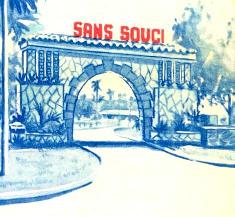SANS SOUCI
Havana Night Club &
Casino
1957
[REF:
Cabaret, April 1957, p36]
CUBA'S CAREFREE CABARET
Massive injections of money for lavish shows,
elaborate gaming facilities have made
Sans Souci Cuba's top club.
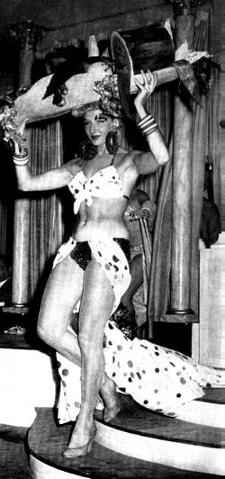
[To see a full size photo, right click and VIEW IMAGE]
[caption] Svelte showgirls
recruited from all over world like curvaceous American,
Inez Rita, parade in shows at club.
page 37
By Jay Mallin
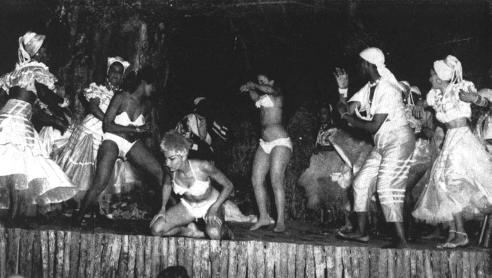
[To see a full size photo, right click and VIEW IMAGE]
[caption] Cuban Voodoo rituals form basis for many shows
at Sans
Souci, where tourists are given insight into Afro-Cuban
traditions.
DURING THE past year a new zest has come into the
traditionally gay and
openhanded atmosphere of Cuban night life, as Havana,
metropolis of the
Caribbean, has once again donned her crown as queen of the
night life
cities South of the Border. New spots have opened, old
ones been
refurbished, and name stars from the U.S. and Europe have
been signed
to appear in them in increasing numbers. Not since the
days of
Prohibition when Havana was a shining haven for revelers
from the
States with a thirst and the wherewithal to quench it, has
the city's
night life boomed as much.
Keynoting and setting the pace for the revival is one of
Havana's
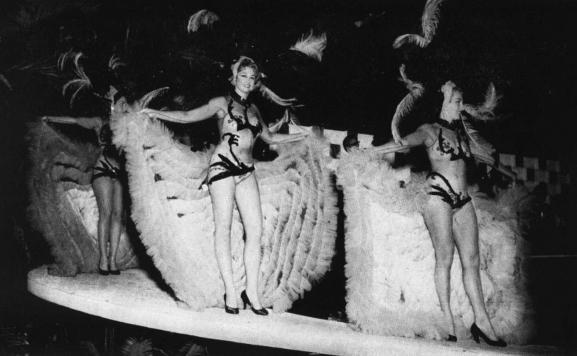
[To see a full size photo, right click and VIEW IMAGE]
[caption] Parading down runway in second part show,
girls
and costumes show other half of night spot' formula:
Follies-type
revues.
page 38
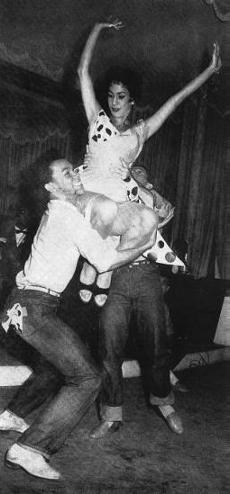
[To see a full size photo, right click and VIEW IMAGE]
PHOTO [caption] Soaring siren, Cara Melo heads Sans Souci
dance troupe,
specializes in wild, uninhibited dances on native
themes. Cara
has been eyed by U.S. producers fro Broadway.
page 39
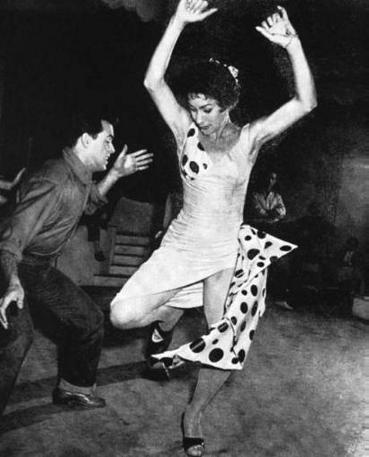 [To see a full size
photo, right click and VIEW IMAGE]
[caption] Whirling through wild ballet based on American
show
dance styles, Cara [Melo] personifies spirit of Sans
Souci. She
is native Cuban, studied dance there.
[To see a full size
photo, right click and VIEW IMAGE]
[caption] Whirling through wild ballet based on American
show
dance styles, Cara [Melo] personifies spirit of Sans
Souci. She
is native Cuban, studied dance there.
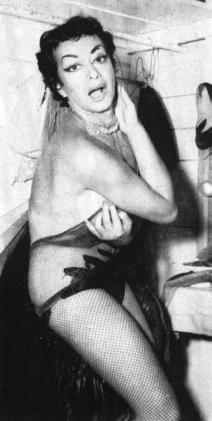
[caption] Backstage, Cara [Melo] hastily changes for
exotic number, conversing in machine-gun Spanish.
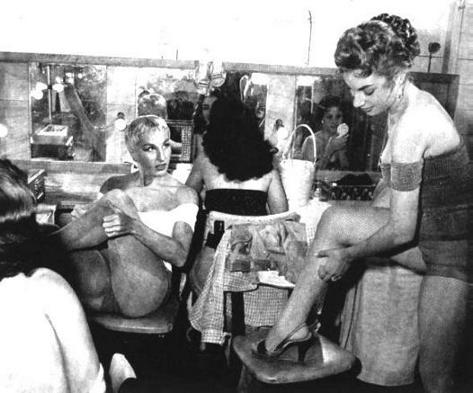
[caption] Dressing room at Sans Souci is busy spot, with
showgirls constantly coming and going as huge productions
move along on
the stage upstairs. Producer Alberto Alonso believes
shows should
be long, colorful.
page 40
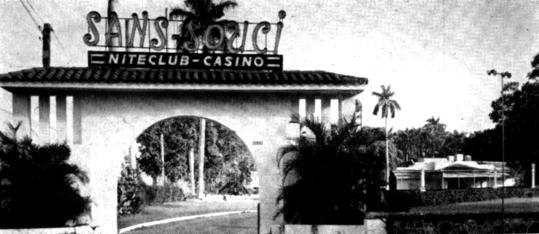
[To see a full size photo, right click and VIEW IMAGE]
[caption] Elaborate entrance lures tourists to club which
can
accommodate over 3,000 guests. In addition to
regular night club
features Sans Souci has elegant gambling salon.
oldest, best known and best night clubs, a lush tropical
center of
outdoor entertainment known appropriately enough as "Sans
Souci."
When a debonair French man about town twirls his mustache
and recounts
for a friend the exploits of the evening before, it's a
cinch that
somewhere in the conversation the words "sans souci" will be
heard. Literally translated, they mean "without care,"
but common
usage has imparted a far greater meaning, implying a good
time with
gaiety running rampant and a tone of devil-may-care that
makes for epic
frolic. It is just such an atmosphere that abounds at
Sans Souci,
where though the club is long-established, there is no trace
of
old-time operation.
"It's like stepping into a movie set of what Hollywood
thinks a
tropical night club should look like," remarked one
bedazzled visitor
who spent an evening and dropped a bundle recently among the
moonlit
Royal Palms that sway overhead to the whisper of soft
tropical breezes.
Reasonably enough, the impetus for the revival typified by
Sans Souci
is again a crackdown in the States--this time on gambling,
and the new
management of Sans Souci is, like that of many of the newer
enterprises, headed by a noted American gambling figureľ
Lefty Clark
of
Miami, onetime operator of some of the Florida
vacationland's best
casinos.
Clark and his associates are reported to have sunk a cool
$1million in
refurbishing the club. Set in rural surroundings and
architecturally of a piece with an Old Spanish villa, its
walls and
halls are lined with very modern, American slot machines,
and the
sing-song chant of the not-so-American croupiers is heard as
the gaming
tables boom in the casino.
As for showmanship, Clark has demonstrated his talents with
a broad and
unerring stroke. He has offered retired heavyweight
champ Rocky
Marciano $350,000 to fight Cuban challenger Nino Valdes at
the club,
and he has dealt with such names as Marlene Dietrich,
Liberace and
Susan Hayward, in lining up entertainment for the coming
season.
Located seven miles outside Havana, Sans Souci was founded
in the days
following World War I, when wealthy Americans traveled and
splurged. It was one of the most popular places in the
world, and
never was completely closed down, though Repeal and the
Great
Depression curtailed its operation as the tourist trade
dwindled to a
trickle and the only traveling Americans were those with
guns on their
shoulders.
Lefty Clark practically rebuilt and also expanded Sans
Souci.
Today it can seat 1,100 easily. On the few nights when
it may
rain, there is ample
page 52
room in the main building for the customers to sit indoors.
The gambling salon is entirely indoors. It has the
usual tables
of roulette, craps, black-jack and chemin de fer (known as
"shimmies"
in the gambling trade). For big gamblers there is a
"money crap
game" in which bettors bet against themselves instead of
against the
house (which simply collects a percentage). (Some
Texans liked
the game so much that Clark kept it going for them through
the night
and well into the next day.)
Indoors there is the Nevada Cocktail Lounge, which provides
its own vocal entertainment in addition to the show outside.
page 54
There is no minimum in the lounge, although there is a $5
minimum per person at the tables in the outdoor area.
Additional attractions are three alternating orchestras, two
shows
nightly and "the most complete menu of any nightclub in
Havana."
And the food is good, too.
A major part of the "million plus" investment has gone into
entertainment. For the first time ever in Cuba a
succession of
well-known entertainment stars have been brought down by a
single
nightclub. In the months since Sans Souci opened this
past
December, it has had more name attractions than all the
other
nightclubs in Cuba have had combined during the past five
years.
The inaugural show starred
Denise Darcel,
an eye-filling French
mademoiselle with a repertoire of sizzling songs. She
was
followed by another exuberant French lady,
Edith Piaf, who
gave forth
with "La Vie en Rose" and "April in Portugal."
The international trend continued with
Ilona Massey,
whose tzigane
numbers were something entirely new in Cuba. Then the
U.S. had
its day with Cab Calloway, whose uninhibited music was much
appreciated
by Cubans and Americans alike.
There then followed, at biweekly intervals, a trio of
singers:
Dorothy
Dandridge,
Joanne Gilbert
and
Tony Martin.
Martin packed in so
many customers that Sans Souci temporarily raised its
minimum one
dollar.
In addition to the name stars, the nightclub has staged the
spectacular
shows which have become a trademark of the big Havana
nightclubs.
The producer is Alberto Alonso, one of the most imaginative
men in the
business in Cuba.
Alonso's "Bamba Iroko Bamba" is staged at Sans Souci at a
cost of
$25,000 weekly. Having no less than 100 performers,
"Bamba" is,
according to Alonso, "the biggest and costliest show ever
put on in
Cuba." It is built around a colorful Afro-Cuban voodoo
theme. ("Bamba" may rival "Sun Sun Babae," the most
famous show
ever staged in a Cuban nightclub. It was put on at
Sans Souci
during 1951-1952 and starred a young female dancer from New
Jersey
named "Skippy.")
Alonso formerly produced the shows at Radiocentro, Havana's
equivalent
of N. Y.'s Radio City Music Hall. When he was signed
up by Sans
Souci, he took his own ballet troupe with him, including the
graceful
and curvy lead dancer, Sonia Calero. (Alonso is the
brother of
Alicia Alonso, the world-famed ballerina.)
In addition to performers, dancers and singers, and the
orchestras,
Sans Souci also boasts a 14-voice choir. This is an
innovation in
nightclubs.
When the new management took over Sans Souci, it not only
had to
refurbish the nightclub's physical plant, but also its
reputation. This had become slightly clouded three
years
previously during the notorious "razzle-dazzle" affair.
Razzle-dazzle is a country carnival game, employing eight
dice and a
board, in which the customer has about one chance in a
thousand of
winning anything. But a glib spiel on the part of the
attending
croupier convinces the unwary that exactly the reverse is
true.
Sometime in 1952 Sans Souci installed a razzle game.
So
successful was it, that within months virtually every Cuban
nightclub
had one. The game made as much money for the clubs as
all their
other games of chance combined: an average of $7,000
nightly.
Because the Havana gambling tables are played mainly by
American
tourists, it was the tourists who were losing heavily.
One
American reportedly lost $30,000 in a single night.
Another lost
$17,000. Complaints poured into the American embassy
and into the
Cuban Tourist Institute.
The Cuban government warned the night-club operators, but
razzle
continued. The warning took the form of a five-hour
shutdown of
all casinos on New Year's Eve, but still razzle
continued. The
Tourist Institute imported a U.S. gambling expert, Fred
Freed, to clean
up the casinos, but so much pressure was brought to bear
that within a
few days of his arrival Freed had to go into hiding.
He soon fled
the country, and the president of the Tourist Institute
resigned.
But the golden flood could not continue indefinitely.
The cries
against razzle inevitably reached the Presidential Palace,
where the
unfavorable publicity Cuba was getting was noted, and soon
President
Fulgencio Batista ordered the police to clean out razzle
once and for
all. This they did with rapid dispatch. Shortly
afterwards
eleven U.S. gamblers were deported from Cuba.
So widespread was the effect of razzle that it even made the
United
States newspapers headlines. A political figure
allegedly lost
more than $4,000 at the game and paid with a bad
check. A suit
was filed in an effort to make good the check.
When the new management took over in 1955, it seriously
considered
renaming the San Souci (possibly to Capacabana or
Copahabana), in order
to get away from the lingering taint. Finally it was
decided,
however, that Sans Souci is almost a Havana landmark, its
name is a
fixture, and the best way to restore it to respectability
would simply
be to operate it respectably.
End of Page
Copyright
1998-2014 Cuban Information Archives. All Rights
Reserved.



[To see a full size photo, right click and VIEW IMAGE]
